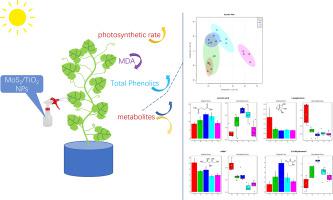当前位置:
X-MOL 学术
›
NanoImpact
›
论文详情
Our official English website, www.x-mol.net, welcomes your
feedback! (Note: you will need to create a separate account there.)
Metabolic profile and physiological response of cucumber foliar exposed to engineered MoS2 and TiO2 nanoparticles
NanoImpact ( IF 4.7 ) Pub Date : 2020-10-01 , DOI: 10.1016/j.impact.2020.100271 Chun Song , Min Huang , Jason C. White , Xiaofeng Zhang , Wenjing Wang , Clement Kyei Sarpong , Zameer Hussain Jamali , Huiling Zhang , Lijuan Zhao , Yu Wang
NanoImpact ( IF 4.7 ) Pub Date : 2020-10-01 , DOI: 10.1016/j.impact.2020.100271 Chun Song , Min Huang , Jason C. White , Xiaofeng Zhang , Wenjing Wang , Clement Kyei Sarpong , Zameer Hussain Jamali , Huiling Zhang , Lijuan Zhao , Yu Wang

|
Abstract Nanoparticle (NPs) use is widespread across a wide range of sectors and accurate assessment of risk and/or benefits posed to important receptors such as plant species is necessary to ensure the sustainable development and application of nanotechnology. Here, 4-week old cucumber plants were foliar exposed to different doses (0–27 mg/plant) of MoS2 or TiO2 NPs for 16 d. Foliar NPs exposure had no impact on plant biomass or photosynthetic pigment production. However, the higher dose of TiO2 NPs exposure decreased lipid peroxidation by 34.7%, and the higher dose of MoS2 and TiO2 NPs exposure significantly increased total phenolics content by 27.4%–28.2%. The photosynthetic rate was increased by 23.6–30.8% with exposure to the higher dose of MoS2 NPs, as well as both lower and higher dose of TiO2 NPs. A metabolomic analysis revealed that 33 metabolites were upregulated or downregulated by MoS2 and TiO2 NPs exposure, including 8 amino acids, 5 organic acids, 3 fatty acids, 5 sugar and sugar derivatives, 4 alcohols, and 3 aromatic compounds. The fluctuation in metabolite content suggests that when plants are exposed to NPs, their metabolic processes are altered, and subsequent responses such as modulated defense, adaptation, and photosynthesis are displayed. With regard to dose, the higher concentration of TiO2 NPs altered several metabolic pathways, including carbohydrate and nitrogen metabolism, whereas the lower dose of TiO2 NPs and both doses of MoS2 had minimal impact on cucumber metabolism. These findings suggest that appropriate doses of MoS2 and TiO2 NPs have the potential to increase plant production by increasing plant photosynthetic rate without inducing excessive stress or toxicity.
中文翻译:

暴露于工程化 MoS2 和 TiO2 纳米颗粒的黄瓜叶的代谢特征和生理反应
摘要 纳米颗粒 (NPs) 的使用广泛应用于各个领域,准确评估对重要受体(如植物物种)造成的风险和/或收益对于确保纳米技术的可持续发展和应用是必要的。在这里,4 周龄的黄瓜植株叶面暴露于不同剂量(0-27 毫克/株)的二硫化钼或二氧化钛纳米颗粒 16 天。叶面纳米颗粒暴露对植物生物量或光合色素的产生没有影响。然而,较高剂量的 TiO2 NPs 暴露降低了 34.7% 的脂质过氧化,而较高剂量的 MoS2 和 TiO2 NPs 暴露显着增加了总酚类物质的含量 27.4%–28.2%。随着暴露于较高剂量的 MoS2 NPs 以及较低和较高剂量的 TiO2 NPs,光合速率增加了 23.6-30.8%。代谢组学分析显示,MoS2 和 TiO2 NPs 暴露可上调或下调 33 种代谢物,包括 8 种氨基酸、5 种有机酸、3 种脂肪酸、5 种糖和糖衍生物、4 种醇和 3 种芳香族化合物。代谢物含量的波动表明,当植物暴露于 NPs 时,它们的代谢过程会发生改变,并显示出随后的反应,如调节防御、适应和光合作用。关于剂量,较高浓度的 TiO2 NPs 改变了几种代谢途径,包括碳水化合物和氮代谢,而较低剂量的 TiO2 NPs 和两种剂量的 MoS2 对黄瓜代谢的影响最小。
更新日期:2020-10-01
中文翻译:

暴露于工程化 MoS2 和 TiO2 纳米颗粒的黄瓜叶的代谢特征和生理反应
摘要 纳米颗粒 (NPs) 的使用广泛应用于各个领域,准确评估对重要受体(如植物物种)造成的风险和/或收益对于确保纳米技术的可持续发展和应用是必要的。在这里,4 周龄的黄瓜植株叶面暴露于不同剂量(0-27 毫克/株)的二硫化钼或二氧化钛纳米颗粒 16 天。叶面纳米颗粒暴露对植物生物量或光合色素的产生没有影响。然而,较高剂量的 TiO2 NPs 暴露降低了 34.7% 的脂质过氧化,而较高剂量的 MoS2 和 TiO2 NPs 暴露显着增加了总酚类物质的含量 27.4%–28.2%。随着暴露于较高剂量的 MoS2 NPs 以及较低和较高剂量的 TiO2 NPs,光合速率增加了 23.6-30.8%。代谢组学分析显示,MoS2 和 TiO2 NPs 暴露可上调或下调 33 种代谢物,包括 8 种氨基酸、5 种有机酸、3 种脂肪酸、5 种糖和糖衍生物、4 种醇和 3 种芳香族化合物。代谢物含量的波动表明,当植物暴露于 NPs 时,它们的代谢过程会发生改变,并显示出随后的反应,如调节防御、适应和光合作用。关于剂量,较高浓度的 TiO2 NPs 改变了几种代谢途径,包括碳水化合物和氮代谢,而较低剂量的 TiO2 NPs 和两种剂量的 MoS2 对黄瓜代谢的影响最小。











































 京公网安备 11010802027423号
京公网安备 11010802027423号